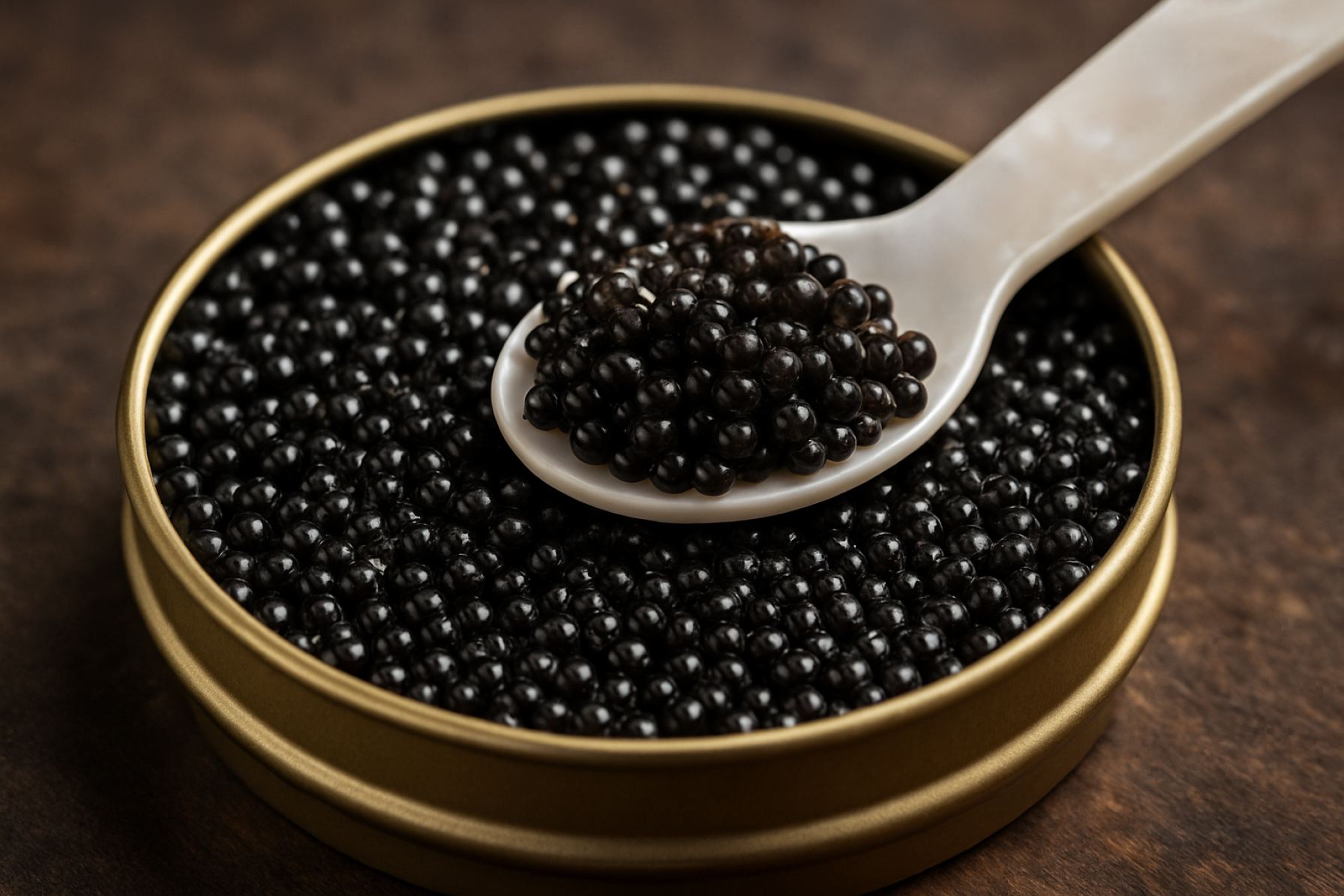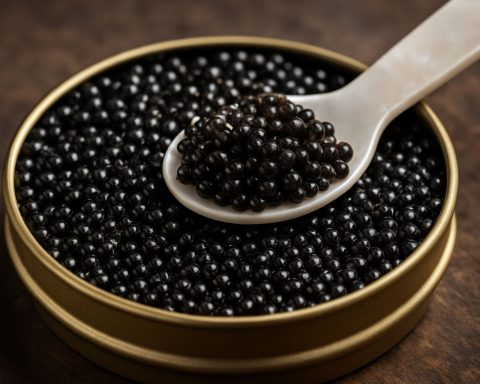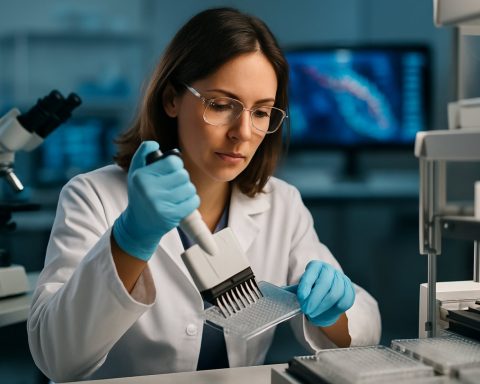Discover the Allure of Hackleback Caviar: America’s Hidden Gem in the World of Luxury Roe. Explore Its Origins, Flavor, and Why It’s Captivating Connoisseurs Everywhere.
- Introduction to Hackleback Caviar
- The Shovelnose Sturgeon: Source of Hackleback
- Harvesting and Production Methods
- Flavor Profile and Culinary Uses
- Nutritional Value and Health Benefits
- Comparing Hackleback to Other Caviars
- Sustainability and Environmental Impact
- Market Trends and Pricing Insights
- How to Select, Store, and Serve Hackleback
- Future Prospects and Innovations in Hackleback Caviar
- Sources & References
Introduction to Hackleback Caviar
Hackleback caviar, also known as Shovelnose Sturgeon caviar, is a distinctive American caviar sourced from the Shovelnose Sturgeon (Scaphirhynchus platorynchus), a species native to the Mississippi and Missouri River basins. Unlike the more widely recognized caviars from the Caspian Sea—such as Beluga, Osetra, and Sevruga—Hackleback caviar is harvested exclusively in the United States, making it a unique and sustainable domestic alternative. The Shovelnose Sturgeon is the smallest species of sturgeon used for caviar production, and its roe is prized for its small, jet-black pearls and firm texture, offering a flavor profile that is both nutty and buttery, with a clean, lingering finish.
The production of Hackleback caviar is regulated to ensure sustainability and the protection of native sturgeon populations. The U.S. Fish and Wildlife Service, a federal agency dedicated to the management and conservation of fish, wildlife, and natural habitats, oversees the harvesting practices and enforces regulations to prevent overfishing and ensure the long-term viability of the species. This regulatory framework distinguishes Hackleback caviar from some international caviars, which have faced challenges related to overexploitation and illegal trade.
Hackleback caviar is often celebrated for its accessibility and value. While it shares many sensory qualities with traditional sturgeon caviars, it is generally more affordable, making it an attractive option for both connoisseurs and newcomers to caviar. Its robust flavor and pleasing texture have earned it a place in fine dining establishments and gourmet markets across the United States. The caviar is typically enjoyed chilled, served on blinis or toast points, and paired with classic accompaniments such as crème fraîche, chives, or hard-boiled eggs.
As the demand for sustainable and locally sourced luxury foods continues to grow, Hackleback caviar has gained recognition as a responsible and high-quality choice. Its production supports American fisheries and contributes to the preservation of native aquatic ecosystems. Organizations such as the World Sturgeon Conservation Society, an international body focused on the research and conservation of sturgeon species, highlight the importance of sustainable practices in caviar production, further underscoring Hackleback caviar’s role in the evolving landscape of gourmet foods.
The Shovelnose Sturgeon: Source of Hackleback
The shovelnose sturgeon (Scaphirhynchus platorynchus) is the primary source of Hackleback caviar, a delicacy prized for its small, jet-black eggs and distinctive flavor profile. Native to the freshwater river systems of the central United States, particularly the Mississippi and Missouri River basins, the shovelnose sturgeon is the smallest sturgeon species found in North America. This species is characterized by its elongated, shovel-shaped snout and streamlined body, which allow it to thrive in the swift currents and sandy bottoms of large rivers.
Unlike many other sturgeon species that are now critically endangered due to overfishing and habitat loss, the shovelnose sturgeon remains relatively abundant in its native range. However, it is still subject to regulatory oversight to ensure sustainable harvests. The U.S. Fish and Wildlife Service, a federal agency responsible for the conservation and management of fish, wildlife, and natural habitats, monitors the population status of the shovelnose sturgeon and enforces regulations on its commercial harvest. In 2010, the shovelnose sturgeon was listed under the Similarity of Appearance provision of the Endangered Species Act to protect the endangered pallid sturgeon, which closely resembles the shovelnose and shares much of its habitat.
Hackleback caviar is harvested from mature female shovelnose sturgeon, typically after they reach reproductive age at around seven to ten years. The caviar is known for its firm texture, glossy appearance, and a flavor that is often described as nutty and buttery, with a clean finish. Because the shovelnose sturgeon matures more quickly and is more prolific than larger sturgeon species such as the beluga or osetra, Hackleback caviar is more accessible and affordable, making it a popular choice in the American caviar market.
The commercial harvest of shovelnose sturgeon for caviar is regulated at both state and federal levels to prevent overexploitation. Many states have established quotas, size limits, and seasonal restrictions to protect spawning populations. Additionally, the U.S. Fish and Wildlife Service collaborates with state agencies and conservation organizations to monitor populations and ensure that harvests remain sustainable. These efforts are crucial for maintaining the ecological balance of river systems and supporting the long-term viability of Hackleback caviar production.
Harvesting and Production Methods
Hackleback caviar, derived from the shovelnose sturgeon (Scaphirhynchus platorynchus), is a distinctive American caviar known for its small, jet-black pearls and robust flavor. The harvesting and production of Hackleback caviar are governed by both ecological considerations and strict regulatory frameworks to ensure sustainability and product quality.
The shovelnose sturgeon is native to the Mississippi and Missouri River basins in the United States. Unlike many other sturgeon species, which are often farmed, Hackleback caviar is primarily sourced from wild-caught fish. The harvesting process is closely monitored by state and federal agencies, such as the U.S. Fish and Wildlife Service, to prevent overfishing and to protect the long-term viability of native sturgeon populations. Fishers must obtain appropriate licenses and adhere to seasonal restrictions, size limits, and quotas designed to minimize ecological impact.
Once harvested, the sturgeon are processed in facilities that comply with food safety and quality standards. The roe is carefully extracted by hand to avoid damaging the delicate eggs. The eggs are then rinsed with cold water to remove impurities and gently sieved to separate them from connective tissue. Salting is a critical step in caviar production, both for flavor and preservation. Hackleback caviar is typically “malossol,” meaning it is lightly salted (usually less than 5% salt by weight), which preserves the natural taste and texture of the eggs.
After salting, the caviar is packed into sterilized containers under hygienic conditions to prevent contamination. The entire process, from harvest to packaging, is often completed within a few hours to maintain freshness and quality. Producers must also comply with regulations set by the U.S. Food and Drug Administration (FDA), which oversees seafood safety and labeling in the United States.
Sustainability is a key concern in Hackleback caviar production. The shovelnose sturgeon is listed under Appendix II of the Convention on International Trade in Endangered Species of Wild Fauna and Flora (CITES), meaning that international trade is regulated to ensure it does not threaten the species’ survival. U.S. producers must document the origin of their caviar and comply with both domestic and international trade requirements.
In summary, Hackleback caviar production is a carefully regulated process that balances the demand for this delicacy with the need to protect wild sturgeon populations and ensure product safety and quality.
Flavor Profile and Culinary Uses
Hackleback caviar, derived from the shovelnose sturgeon (Scaphirhynchus platorynchus) native to the Mississippi and Missouri River basins, is celebrated for its distinctive flavor and versatility in culinary applications. The eggs are small to medium in size, typically jet black to dark brown, and possess a firm texture that provides a pleasing pop when eaten. The flavor profile of Hackleback caviar is often described as clean, nutty, and buttery, with subtle earthy undertones and a mild brininess that is less intense than that of many imported sturgeon caviars. This makes it particularly approachable for those new to caviar, while still offering complexity appreciated by connoisseurs.
The unique taste and texture of Hackleback caviar lend themselves to a variety of culinary uses. Traditionally, it is served simply—chilled, on blinis or toast points, and accompanied by classic garnishes such as crème fraîche, chives, or hard-boiled eggs. Its robust flavor also allows it to stand out in more creative preparations, such as atop deviled eggs, oysters, or even as a luxurious finish to seafood dishes and pasta. Chefs value Hackleback caviar for its ability to elevate both simple and sophisticated recipes without overpowering other ingredients.
In addition to its flavor, Hackleback caviar is prized for its sustainability and domestic origin. The shovelnose sturgeon is one of the few sturgeon species harvested in the United States, and its caviar is regulated to ensure responsible sourcing. Organizations such as the U.S. Fish and Wildlife Service oversee the management of wild sturgeon populations, contributing to the long-term viability of this delicacy. As a result, Hackleback caviar is often featured in restaurants and specialty food markets that prioritize local and sustainable ingredients.
The accessibility and relatively moderate price point of Hackleback caviar, compared to imported varieties like Beluga or Osetra, have contributed to its growing popularity among both professional chefs and home gourmets. Its adaptability in both traditional and modern cuisine, combined with its distinctive American character, ensures that Hackleback caviar remains a sought-after choice for those seeking a refined yet approachable caviar experience.
Nutritional Value and Health Benefits
Hackleback caviar, derived from the shovelnose sturgeon (Scaphirhynchus platorynchus) native to the Mississippi and Missouri River basins, is recognized not only for its distinctive flavor and texture but also for its notable nutritional profile. Like other types of sturgeon caviar, hackleback caviar is a nutrient-dense food, offering a range of essential vitamins, minerals, and beneficial fatty acids.
A primary nutritional highlight of hackleback caviar is its high content of omega-3 fatty acids, particularly eicosapentaenoic acid (EPA) and docosahexaenoic acid (DHA). These long-chain polyunsaturated fats are well-documented for their role in supporting cardiovascular health, reducing inflammation, and contributing to optimal brain function. Regular consumption of omega-3-rich foods like caviar has been associated with a lower risk of heart disease and improved cognitive performance, as recognized by organizations such as the American Heart Association.
In addition to healthy fats, hackleback caviar is a rich source of high-quality protein, providing all essential amino acids necessary for tissue repair, muscle maintenance, and overall metabolic health. The protein content in caviar is easily digestible, making it a valuable addition to a balanced diet.
Hackleback caviar also contains significant amounts of vitamins and minerals. It is particularly high in vitamin B12, a nutrient crucial for red blood cell formation, neurological function, and DNA synthesis. A single serving of caviar can provide several times the recommended daily intake of vitamin B12, making it an excellent dietary source for this essential vitamin. Other B vitamins, such as riboflavin (B2), pantothenic acid (B5), and folate (B9), are also present, supporting energy metabolism and nervous system health.
Mineral-wise, hackleback caviar is a good source of selenium, iron, magnesium, and calcium. Selenium acts as a powerful antioxidant, protecting cells from oxidative stress, while iron is vital for oxygen transport in the blood. Magnesium and calcium contribute to bone health and proper muscle function.
It is important to note that, like most caviars, hackleback caviar can be relatively high in sodium due to the salting process used in its preparation. Individuals monitoring their sodium intake should consume caviar in moderation.
Overall, hackleback caviar offers a unique combination of nutrients that can support heart, brain, and metabolic health when enjoyed as part of a varied and balanced diet. Its nutritional value is recognized by food safety and nutrition authorities, including the U.S. Food and Drug Administration, which provides guidelines on fish and seafood consumption for optimal health.
Comparing Hackleback to Other Caviars
Hackleback caviar, derived from the shovelnose sturgeon (Scaphirhynchus platorynchus), is a distinctive American caviar that stands apart from more traditional varieties such as Beluga, Osetra, and Sevruga. The shovelnose sturgeon is native to the Mississippi and Missouri River basins, making Hackleback one of the few wild-caught caviars still legally available in the United States. This contrasts with the majority of global caviar production, which now relies heavily on aquaculture due to conservation concerns and international trade restrictions on wild sturgeon species, particularly those listed under CITES (CITES), the Convention on International Trade in Endangered Species of Wild Fauna and Flora.
In terms of appearance and texture, Hackleback caviar features small, jet-black eggs with a firm texture and a glossy sheen. The grains are generally smaller than those of Beluga caviar, which is renowned for its large, delicate pearls. Osetra caviar, sourced from the Russian sturgeon (Acipenser gueldenstaedtii), typically has medium-sized eggs with a range of colors from golden to brown, while Sevruga caviar, from the starry sturgeon (Acipenser stellatus), is known for its small, grayish eggs. Hackleback’s eggs are often compared to Sevruga in size, but they are darker and firmer.
Flavor is another key differentiator. Hackleback caviar is prized for its clean, nutty, and buttery taste, with a subtle brininess and a lingering finish. This profile is less intense than the rich, creamy, and sometimes earthy notes of Beluga, and less complex than the often nutty and fruity flavors of Osetra. Sevruga caviar, on the other hand, is typically saltier and more pronounced in flavor, making Hackleback a milder alternative for those new to caviar or seeking a more approachable option.
Economically, Hackleback caviar is more accessible than its Old World counterparts. The relative abundance of shovelnose sturgeon in American rivers and the shorter time to maturity (typically 7-10 years, compared to up to 20 years for Beluga) contribute to its lower price point. This makes Hackleback a popular choice for both restaurants and consumers seeking authentic sturgeon caviar without the premium cost associated with imported varieties. Regulatory oversight by agencies such as the U.S. Fish and Wildlife Service ensures that Hackleback caviar is harvested sustainably, further distinguishing it from caviars that have faced overfishing and population decline.
In summary, Hackleback caviar offers a unique combination of American origin, firm texture, mild flavor, and affordability, setting it apart from the more traditional and often more expensive caviars of Eurasian origin. Its sustainable sourcing and legal status in the U.S. market further enhance its appeal among both connoisseurs and newcomers to caviar.
Sustainability and Environmental Impact
Hackleback caviar, derived from the shovelnose sturgeon (Scaphirhynchus platorynchus), is notable for its unique position in the caviar market, particularly regarding sustainability and environmental impact. Unlike many traditional caviar sources, such as the beluga or Russian sturgeon, the shovelnose sturgeon is native to the rivers of the central United States and is not currently listed as endangered. This status is a significant factor in the sustainability profile of hackleback caviar, as overfishing and habitat loss have severely impacted other sturgeon species worldwide.
The management of shovelnose sturgeon populations falls under the jurisdiction of state and federal agencies, including the U.S. Fish and Wildlife Service. These organizations regulate harvest quotas, fishing seasons, and size limits to ensure that wild populations remain stable. In 2010, the U.S. Fish and Wildlife Service listed the shovelnose sturgeon as threatened under the Similarity of Appearance provision of the Endangered Species Act, primarily to protect the endangered pallid sturgeon, which shares its habitat and can be confused with the shovelnose. This regulatory framework has contributed to more responsible harvesting practices and increased oversight of the caviar trade.
From an environmental perspective, hackleback caviar production generally has a lower ecological footprint compared to caviar sourced from overexploited or farmed sturgeon in other regions. The shovelnose sturgeon is a smaller species with a faster reproductive cycle, allowing for more sustainable population management. Additionally, because hackleback caviar is often sourced from wild-caught fish in regulated fisheries, it avoids some of the environmental concerns associated with intensive aquaculture, such as water pollution, disease transmission, and habitat modification.
However, challenges remain. The shovelnose sturgeon’s riverine habitats are vulnerable to pollution, dam construction, and waterway modification, which can impact both the species and the broader ecosystem. Continued vigilance by regulatory bodies and adherence to science-based management practices are essential to ensure that hackleback caviar remains a sustainable choice. Organizations such as the U.S. Fish and Wildlife Service and state wildlife agencies play a critical role in monitoring populations and enforcing regulations to prevent overharvesting and habitat degradation.
In summary, hackleback caviar represents a more sustainable alternative within the caviar industry, provided that current management and conservation measures are maintained and adapted as necessary. Ongoing collaboration between fisheries managers, conservation organizations, and the caviar industry is vital to balancing economic interests with the long-term health of wild sturgeon populations and their habitats.
Market Trends and Pricing Insights
Hackleback caviar, derived from the Shovelnose Sturgeon (Scaphirhynchus platorynchus), is a prominent American caviar known for its small, jet-black pearls and robust, nutty flavor. As a native species to the Mississippi and Missouri River basins, Hackleback caviar has gained popularity in both domestic and international markets due to its sustainable sourcing and relatively accessible price point compared to imported sturgeon caviars.
In recent years, the market for Hackleback caviar has experienced steady growth, driven by increasing consumer interest in sustainable and locally sourced luxury foods. The United States, as one of the few countries with a significant wild sturgeon population, has positioned Hackleback caviar as a viable alternative to traditional Caspian Sea caviars, which face stricter international trade regulations and higher prices due to overfishing and conservation concerns. The U.S. Fish and Wildlife Service, which oversees the management and conservation of native sturgeon species, has implemented regulations to ensure the sustainable harvest of Shovelnose Sturgeon, further supporting the long-term viability of Hackleback caviar in the market.
Pricing for Hackleback caviar is generally more accessible than that of imported Beluga, Osetra, or Sevruga caviars. As of 2024, retail prices for Hackleback caviar typically range from $40 to $80 per ounce, depending on factors such as grade, packaging, and supplier. This price positioning makes Hackleback caviar attractive to both gourmet consumers and the hospitality industry seeking high-quality caviar at a lower cost. The relatively short time to market—Shovelnose Sturgeon reach maturity faster than many other sturgeon species—also contributes to stable supply and competitive pricing.
Market trends indicate a growing preference for traceable, sustainably sourced caviar, with consumers and chefs increasingly seeking out American caviars like Hackleback. Organizations such as the Convention on International Trade in Endangered Species of Wild Fauna and Flora (CITES) play a role in regulating international trade of sturgeon products, further highlighting the importance of domestic, legally harvested caviar. As awareness of sustainability and local sourcing continues to rise, Hackleback caviar is expected to maintain its market share and potentially expand, especially as global supplies of traditional sturgeon caviars remain constrained.
In summary, Hackleback caviar’s market is characterized by sustainable sourcing, competitive pricing, and increasing consumer demand for American-produced luxury foods. Ongoing regulatory oversight and shifting consumer preferences are likely to support continued growth and stability in this segment of the caviar market.
How to Select, Store, and Serve Hackleback
Selecting, storing, and serving Hackleback caviar requires attention to detail to preserve its delicate flavor and texture. Hackleback caviar, sourced from the wild American Shovelnose Sturgeon (Scaphirhynchus platorynchus), is prized for its small, jet-black pearls and nutty, buttery taste. It is one of the few wild sturgeon caviars legally harvested in the United States, making it a sustainable and accessible choice for caviar enthusiasts.
How to Select Hackleback Caviar
When selecting Hackleback caviar, prioritize freshness and quality. Look for caviar that is glossy, with firm, intact eggs that separate easily. The aroma should be clean and reminiscent of the sea, without any off or overly fishy odors. Reputable suppliers will provide information about the harvest date and storage conditions. Always purchase from licensed dealers who comply with food safety and sustainability standards, such as those regulated by the U.S. Food and Drug Administration and the U.S. Fish and Wildlife Service, which oversee the legal harvest and sale of sturgeon products in the United States.
Proper Storage Techniques
Caviar is highly perishable and should be kept as cold as possible without freezing. Store Hackleback caviar in the coldest part of your refrigerator, ideally at temperatures between 28°F and 32°F (-2°C to 0°C). Unopened tins or jars can typically be stored for up to four weeks, but once opened, caviar should be consumed within 2–3 days for optimal freshness. To prevent oxidation and preserve flavor, keep the caviar container tightly sealed and avoid exposure to air. For best results, place the container on a bed of ice when serving or storing for short periods.
Serving Suggestions
To fully appreciate Hackleback caviar’s nuanced flavor, serve it chilled and avoid using metal utensils, which can impart a metallic taste. Instead, use mother-of-pearl, bone, or glass spoons. Traditional accompaniments include blinis, toast points, or unsalted crackers, along with crème fraîche, chopped egg, and chives. However, many aficionados prefer to enjoy Hackleback caviar on its own to savor its unique profile. Serve small portions, as caviar is best enjoyed in moderation to appreciate its texture and taste.
By following these guidelines, you can ensure that Hackleback caviar retains its premium quality from selection to serving, providing a luxurious and authentic tasting experience.
Future Prospects and Innovations in Hackleback Caviar
The future of Hackleback caviar, derived from the native American shovelnose sturgeon (Scaphirhynchus platorynchus), is shaped by a combination of ecological stewardship, technological innovation, and evolving consumer preferences. As global demand for sustainable and traceable luxury foods increases, Hackleback caviar is positioned to play a significant role in the caviar market, particularly within the United States.
One of the most promising areas for future development is the advancement of aquaculture techniques. Traditionally, Hackleback caviar has been sourced from wild populations in the Mississippi and Missouri River basins. However, concerns about overfishing and habitat degradation have prompted regulatory bodies such as the U.S. Fish and Wildlife Service to implement stricter management and conservation measures. These efforts are encouraging producers to invest in closed-system aquaculture, which allows for controlled breeding, improved biosecurity, and reduced environmental impact. Innovations in recirculating aquaculture systems (RAS) are particularly relevant, as they enable year-round production and minimize water usage, aligning with broader sustainability goals.
Genetic research and selective breeding are also expected to enhance the quality and consistency of Hackleback caviar. By identifying desirable traits such as faster growth rates, disease resistance, and optimal roe characteristics, producers can improve yields and product uniformity. Collaboration with academic institutions and organizations like the U.S. Geological Survey, which conducts research on native fish populations and aquatic ecosystems, is likely to accelerate these advancements.
Traceability and transparency are becoming increasingly important to both regulators and consumers. The adoption of digital tracking systems, such as blockchain-based platforms, can provide end-to-end documentation of caviar provenance, from hatchery to harvest. This not only helps combat illegal, unreported, and unregulated (IUU) fishing but also reassures buyers about the authenticity and ethical sourcing of Hackleback caviar. The Convention on International Trade in Endangered Species of Wild Fauna and Flora (CITES) plays a key role in regulating international trade and ensuring that sturgeon products are sourced sustainably.
Looking ahead, the integration of sustainable aquaculture, genetic innovation, and digital traceability is expected to secure the future of Hackleback caviar. As environmental regulations tighten and consumer awareness grows, producers who embrace these innovations will be best positioned to meet market demands while safeguarding the species and its habitat for future generations.







